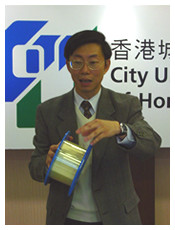Fibreoptics breakthrough
CityU scientists have developed an optical fibre that is expected to revolutionize wideband telecommunications by enhancing the quality and stability of high bandwidth data transmission.
"The development could help to lower the cost of ultra wideband telecommunications internationally," Professor Chiang said. An overseas collaborator is currently working with Professor Chiang to bring the new fibre to market.
Driven by ever-increasing data transmission demands, scientists in the optical fibre community had been struggling for years to enlarge the size of the optical fibre core without reducing transmission quality. The market demand for bandwidth is currently 10 gigabytes per second, equivalent to 120,000 simultaneous telephone transmissions.
Professor Chiang, who invented the revolutionary fibreoptic design with his research fellow, Dr Vipur Rastogi, was recently elected a Fellow of the Optical Society of America in recognition of his extensive contributions to fibre and integrated optics, particularly the theory, simulation and characterization of optical fibres and wavelengths.In 1999, Professor Chiang was awarded the Croucher Senior Research Fellowship. He holds two patents and has published over 200 papers in international journals and conference proceedings, as well as several book chapters.

